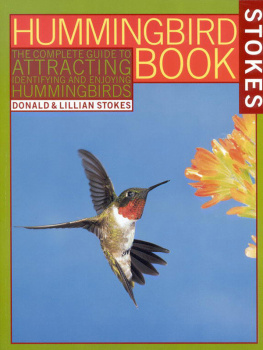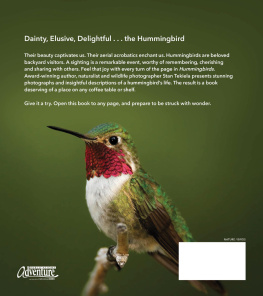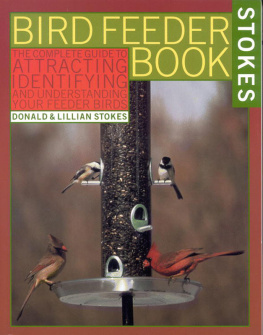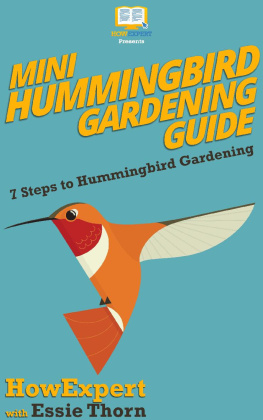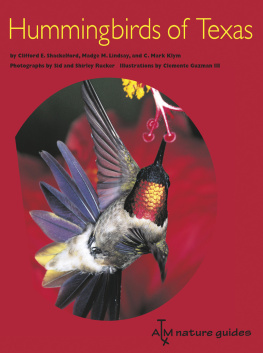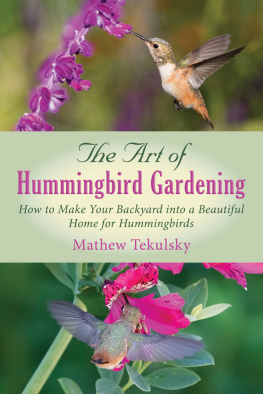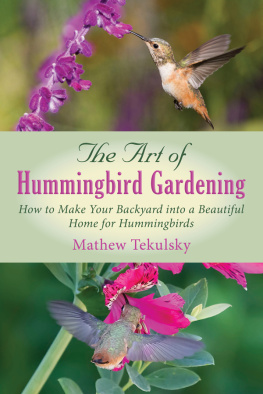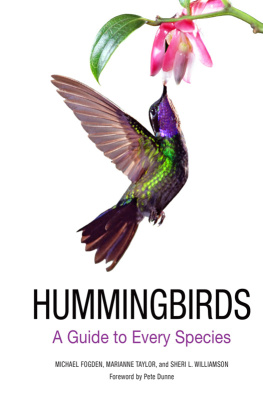COPYRIGHT 1989 BY DONALD W. STOKES AND LILLIAN Q. STOKES
ALL RIGHTS RESERVED. EXCEPT AS PERMITTED UNDER THE U.S. COPYRIGHT ACT OF 1976, NO PART OF THIS PUBLICATION MAY BE REPRODUCED, DISTRIBUTED, OR TRANSMITTED IN ANY FORM OR BY ANY MEANS, OR STORED IN A DATABASE OR RETRIEVAL SYSTEM, WITHOUT THE PRIOR WRITTEN PERMISSION OF THE PUBLISHER.
LITTLE, BROWN AND COMPANY
HACHETTE BOOK GROUP
237 PARK AVENUE, NEW YORK, NY 10017
VISIT OUR WEB SITE AT WWW.HACHETTEBOOKGROUP.COM.
FIRST EBOOK EDITION
ISBN: 978-0-316-04847-7
Designed by Donald and Lillian Stokes
The Little, Brown and Company name and logo are trademarks of Hachette Book Group, Inc.
Stokes Hummingbird Book
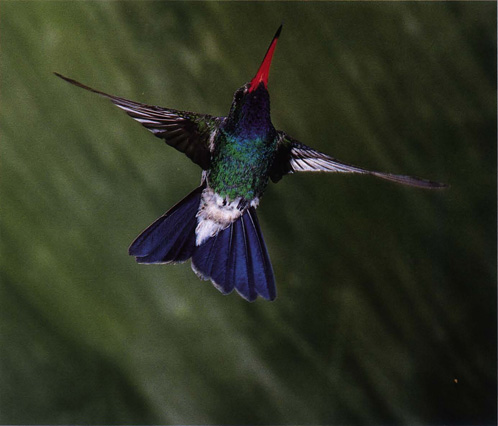
What heavenly tints in mingling radiance fly!
Each rapid movement gives a different dye;
Like scales of burnished gold they dazzling show
Now sink to shade, now like a furnace glow!
Alexander Wilson, 17761813
Early American Ornithologist
Stokes Field Guides
Stokes Field Guide to Birds: Eastern Region
Stokes Field Guide to Birds: Western Region
Stokes Field Guide to Bird Songs: Eastern Region (CD/cassette)
Stokes Field Guide to Bird Songs: Western Region (CD/cassette)
Stokes Beginner's Guides
Stokes Beginner's Guide to Bats
Stokes Beginner's Guide to Bird Feeding
Stokes Beginner's Guide to Birds: Eastern Region
Stokes Beginner's Guide to Birds: Western Region
Stokes Beginner's Guide to Butterflies
Stokes Beginner's Guide to Dragonflies
Stokes Beginner's Guide to Hummingbirds
Stokes Beginner's Guide to Shorebirds
Stokes Backyard Nature Books
Stokes Bird Feeder Book
Stokes Bluebird Book
Stokes Butterfly Book
Stokes Hummingbird Book
Stokes Birdhouse Book
Stokes Purple Martin Book
Stokes Bird Gardening Book
Stokes Wildflower Book: East of the Rockies
Stokes Wildflower Book: From the Rockies West
Stokes Oriole Book
Stokes Nature Guides
Stokes Guide to Bird Behavior, Vol. I
Stokes Guide to Bird Behavior, Vol. II
Stokes Guide to Bird Behavior, Vol. III
Stokes Guide to Animal Tracking and Behavior
Stokes Guide to Nature in Winter
Stokes Guide to Observing Insect Lives
Stokes Guide to Enjoying Wildflowers
Stokes Guide to Amphibians and Reptiles
Other Stokes Books
The Natural History of Wild Shrubs and Vines

A male ruby-throated hummingbird, taking nectar from wild columbine.
Attracting Hummingbirds
We will never forget our first look at a hummingbird, many years ago. We had dutifully planted our property with the flowers we knew hummingbirds liked and had hung up hummingbird feeders, but no hummingbirds had arrived. After several months of waiting, we were just about to give up when one day we went to the garden to admire the first bloom of the cardinal flower.
Suddenly, a flash of iridescence caught our eye and poof, a female ruby-throated hummingbird hovered right before us. It reminded us of that famous pixie, Tinker Bell, from the story of Peter Pan, and for a moment we expected a sprinkling of pixie dust to float down upon us.
From that magic day on, hummingbirds have been a part of our lives and have enchanted us every spring through every fall. Whenever we watch them our minds leave our human concerns, and we experience a renewed sense of wonder and appreciation for the living things around us.
We have written this book for you, so that you too might bring the magic of hummingbirds into your life.
It is not hard to attract hummingbirds almost anywhere in the United States and southern Canada if you create favorable habitats and put up hummingbird feeders. We will show you how to do this and will explain how to identify hummingbirds and how to photograph hummingbirds. Then we will reveal all the fascinating features of hummingbird behavior that you can watch for and that will expand your feeling of amazement about these tiniest birds.
So start today. Use this guide to attract and enjoy hummingbirds. We guarantee your life will be the richer for it.
We wish you good luck and Happy Hummingbirding!
Don and Lillian Stokes
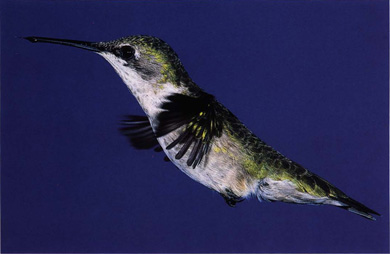
A female ruby-throated hummingbird hovering.
One of the best ways to attract hummingbirds and thus have the enjoyment of watching them in your yard is to buy a hummingbird feeder, fill it with a sugar-water solution, and place it in your garden. Putting it near flowers to which hummingbirds may be drawn will make it even more attractive.
Commercial Feeders
There are many fine commercial hummingbird feeders now on the market, with new ones appearing all the time. Most of these feeders have flower patterns or red parts on them so that they are attractive to hummingbirds.
There are basically two designs. One type consists of an inverted bottle that empties into a lower reservoir with feeding holes. The vacuum created at the top of the bottle is what keeps the liquid from draining out. The simplest form of this type of feeder is a small inverted bottle with a rubber stopper and glass tube coming out the bottom.
The other type of feeder is simply a container with holes in its cover through which the hummers reach to get the fluid. Many of these are thin disks with representations of flowers on the upper surface. You may want to experiment with different models of feeders to find which ones work best for you.
How to Choose
When choosing a feeder, look at it carefully. Ask the store attendant if you can take it apart, for this is essential to cleaning it out. You will be doing lots of filling and cleaning of the feeder, so make sure you can reach all areas to scrub them thoroughly. (People use bottle brushes and pipe cleaners to make this job easier.)
Start with smaller feeders and wait until your hummingbird customers are regularly emptying these before going for the larger sizes. This will ensure that your feeder solution will not sit too long in the feeder and spoil. If someone gives you a larger-size feeder as a gift, remember that you do not have to fill it all the way up; just put in the amount of solution that the hummingbirds will consume in a day or two.
There are feeders made out of plastic or glass or a combination of the two. There are pros and cons to the use of each material. Plastic doesn't break, but, on the other hand, some people feel that glass is easier to clean. There are many quality feeders on the market made out of each material.
To Perch or Not to Perch
Perches are a useful, although not essential, feature on hummingbird feeders. If the feeder has perches, the hummers will use them. If it doesn't, the hummers will happily hover at the feeding holes, just the way they do when drinking from flowers in the wild. When they want to perch they will go to a nearby shrub or tree. Hummingbirds take frequent breaks from their energy-intensive hovering flight; one study found that they spend over 60 percent of their time perched. One potential problem with perches: larger birds, such as orioles, may use the perches to get at the sugar water and exclude the hummingbirds. You can get around this problem by temporarily removing the perches or adding feeders without perches.

